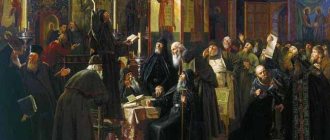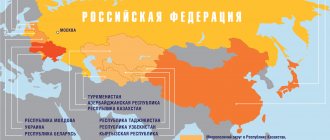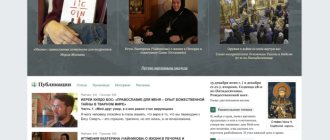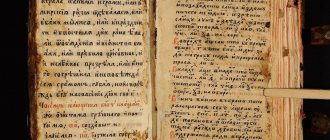| Christianity Christian Portal | |
| Bible Old Testament · New Testament Apocrypha Gospel Ten Commandments Sermon on the Mount | |
| Trinity God the Father God the Son (Jesus Christ) Holy Spirit | |
| History of Christianity Chronology of Christianity Apostles Ecumenical Councils Great Schism Crusades Reformation | |
| Christian theology Fall · Sin · Grace Redemptive sacrifice Salvation · Second Coming Christian worship Christian Christian virtues | |
| Main directions Catholicism · Orthodoxy Monophysitism · Nestorianism Protestantism Christian values Christian movement Ecumenism Conservatism · Liberalism | |
| UDC | 23/28 |
Christianity
- the religion of Christians (disciples and followers of Jesus Christ).
Content
- 1 The emergence of Christianity
- 2 Christian denominations and teachings 2.1 Catholicism
- 2.2 Orthodoxy 2.2.1 Pre-Chalcedonian churches
- 3.1 Theology
- 4.1 Pre-Nicene period (1st - beginning of 4th century) 4.1.1 Apostolic age
- 4.2.1 Rise of monasticism in Egypt, Syria and Palestine
- 4.3.1 Division of churches ( formally
1054)
- 7.1 Denial and criticism of Christianity
Literature[ | ]
- Adolf von Harnack. History of dogmas // Op.: History of dogmas, in the book: General history of European culture, St. Petersburg, 1911, vol. 6
- Bart K. Essay on Dogmatics. St. Petersburg, 2000.
- Hippolytus of Rome. Apostolic Tradition
- Blessed Augustine of Ippona. About the Creed.
- Archbishop Vasily (Krivoshein). Symbolic texts in the Orthodox Church.
- Zaitsev A. A.
Doctrine // Orthodox Encyclopedia. - M., 2002. - T. 8. - P. 8-11. — ISBN 5-89572-010-2. - Noll M. A. (English) Russian.
Confessions of Faith // Theological Encyclopedic Dictionary = Evangelical Dictionary of Theology (English) Russian. / Ed. W. Elville (English)Russian; lane from English T. Yu. Vasilyeva, D. B. Gorbatov, A. E. Grafov, A. V. Kurt, V. V. Rynkevich, Yu. M. Tabak, D. A. Eisner. - M.: Association "Spiritual Revival" ECB, 2003. - P. 527-532. — 1488 p. — ISBN 5-87727-030-3.
| Dictionaries and encyclopedias |
|
The emergence of Christianity
File:Christianity percentage by country.PNG The number of Christian parishioners by country as a percentage.
Christianity began in the 1st century in Israel in the context of the messianic movements of Judaism. Yeshua (Jesus) was raised as a Jew, observed the Torah, attended synagogue on Shabbat, and observed holidays. The first of the apostles (disciples of Yeshua) were Jews. According to the New Testament text of the Acts of the Apostles (Acts 11:26), the noun “Χριστιανοί”
- Christians, adherents (or followers) of Christ, first came into use to designate supporters of the new faith in the Syriac-Hellenistic city of Antioch in the 1st century.
Initially, Christianity spread among the Jews of Palestine and the Mediterranean diaspora, but, starting from the first decades, thanks to the preaching of the Apostle Paul, it gained more and more followers among other peoples (“pagans”). Until the 5th century, the spread of Christianity occurred mainly within the geographical boundaries of the Roman Empire, as well as in the sphere of its cultural influence (Armenia, eastern Syria, Ethiopia), later (mainly in the 2nd half of the 1st millennium) - among the Germanic and Slavic peoples, later (by the XIII-XIV centuries) - also among the Baltic and Finnish peoples. In modern and recent times, the spread of Christianity outside of Europe occurred due to colonial expansion and the activities of missionaries. Currently, the number of Christian adherents worldwide exceeds 1 billion (not confirmed)
, of which in Europe - about 475 million, in Latin America - about 250 million, in North America - about 155 million, in Asia - about 100 million, in Africa - about 110 million; Catholics - about 660 million, Protestants - about 300 million (including 42 million Methodists and 37 million Baptists), Orthodox and adherents of “non-Chalcedonian” religions of the East (Monophysites, Nestorians, etc.) - about 120 million.
Christian denominations and teachings
| Branches of Christianity | |
| Orthodoxy Autocephalous Orthodox churches
Autonomous Orthodox churches Old Believers Non-canonical Orthodox associations Bulgarian Old Calendar Church Catholicism Protestantism Ancient Eastern churches Armenian Apostolic Church
Antitrinitarianism Restorationism Others Template: View·Discuss·Edit | |
Main article
:
Branches of Christianity
Today in Christianity there are the following main directions:
- Catholicism
- Orthodoxy
- Protestantism
Catholicism
- Catholic Church Roman Catholic Church
- Eastern Catholic churches
Orthodoxy
- Orthodox Church
- Old Believers
- Bespovostvo
- Fugitiveism
Pre-Chalcedonian churches
The so-called Orthodox Christians are sometimes considered Pre-Chalcedonian churches:
- Monophysitism Armenian Apostolic Church
- Coptic Church
- Syro-Jacobite Orthodox Church
Protestantism
- Seventh-day Adventists
- Anglican Church
- Baptistism
- Evangelical Christians
- Calvinism
- Quakers
- Lutheranism
- Mennonism
- Methodism
- Molokanism
- Presbyterianism
- Pentecostals
- Charismatics (neo-Pentecostals)
In other religions
| This section (or several sections) has not yet been written. According to the plan of one or more Wikipedia contributors, this place should contain a section (or several sections) dedicated to non-Christian beliefs . |
Munism
The doctrine of the Unification Church preaches that the second Adam, in the person of Jesus Christ, provided only spiritual salvation after the crucifixion. Therefore, a third Adam was needed to provide physical salvation.[35]
Creed
Theology
See also: Trinity
Christianity accepts the Old Testament tradition, dating back to Abraham, of the veneration of one God (monotheism), the creator of the Universe and man. At the same time, Christianity introduces into monotheism the idea of a triple personality (God, Logos, Holy Spirit) possessing a single essence.
Main features of the Christian religion
- 1) spiritualistic monotheism,
deepened by the doctrine of the
trinity
of Persons in the single being of the Divine. This teaching has given and continues to give rise to the deepest philosophical and religious speculation, revealing the depth of its content over the centuries from new and new sides (see Trinity);
Trinity. Work by Andrey Rublev
- 2) the concept of God as an absolutely perfect Spirit, not only absolute Reason and Omnipotence, but also absolute Goodness and Love (God is love);
- 3) the doctrine of the absolute value of the human person
as an immortal, spiritual being created by God in His image and likeness, and the doctrine of the equality of all people in their relationship to God: they are still loved by Him, like children of the Heavenly Father, all are destined for eternal blissful existence in union with God, everyone is given the means to achieve this destiny - free will and divine grace; - 4) the doctrine of the ideal purpose of man,
which consists in
endless,
comprehensive, spiritual
improvement
(be perfect, as your Heavenly Father is perfect); - 5) the doctrine of the complete dominance of the spiritual principle over matter: God is the unconditional Lord of matter, as its Creator: He has given man dominion over the material world in order to fulfill his ideal purpose through the material body and in the material world; Thus, Christianity, dualistic in metaphysics
(since it accepts two foreign substances - spirit and matter), is monistic as
a religion,
for it places matter in
unconditional dependence
on the spirit, as a creation and medium for the activity of the spirit. Therefore it - 6) equally far from
metaphysical and moral materialism,
and from hatred towards matter and the material world
as such.
Evil is not in matter and not from matter, but from the perverted free will of spiritual beings (angels and humans), from whom it passed onto matter (“cursed is the earth for your deeds
,” God says to Adam; during creation, everything was “good and evil” "). This sober and at the same time highly ideal view of Christianity on matter received its best expression in
Annunciation
- 7) the doctrine of the resurrection of the flesh
and the bliss of the resurrected flesh of the righteous together with their souls in the enlightened, eternal, material world and  in the second cardinal dogma of Christianity - in the teaching about the God-man, about the Eternal Son of God truly incarnate and made human to save people from sin, curse and death, identified by the Christian church with its Founder, Jesus Christ. Thus, Christianity, with all its impeccable idealism, is a religion of harmony
in the second cardinal dogma of Christianity - in the teaching about the God-man, about the Eternal Son of God truly incarnate and made human to save people from sin, curse and death, identified by the Christian church with its Founder, Jesus Christ. Thus, Christianity, with all its impeccable idealism, is a religion of harmony
of matter and spirit; it does not curse or deny any of the spheres of human activity, but ennobles them all, inspiring us to remember that they are all only means for man to achieve spiritual, god-like perfection.
In addition to these features, the indestructibility of the Christian religion is facilitated by:
- 1) the essential metaphysical nature
of its content, making it invulnerable to scientific and philosophical criticism and - 2) for the Catholic churches of the East and West - the doctrine of the infallibility of the church
in matters of dogma due to the Holy Spirit acting in it at all times - a doctrine that, in the correct understanding, protects it, in particular, from historical and historical-philosophical criticism.
These features, carried by Christianity through two millennia, despite the abyss of misunderstandings, hobbies, attacks, and sometimes unsuccessful defenses, despite all the abyss of evil that was and is being done supposedly in the name of Christianity, lead to the fact that if Christian teaching could always be accepted and not accept, believe in it or not believe, then refute
it is
not possible
and will never be possible. To the indicated features of the attractiveness of the Christian religion, it is necessary to add one more and by no means the least: the incomparable Personality of its Founder. To renounce Christ is perhaps even much more difficult than to renounce Christianity.
Christology
Christology is the doctrine of Jesus Christ. The Orthodox (Catholic, Orthodox, and Protestant) view holds that Jesus Christ is the God-man—not a demigod or a hero, but a being who combines in his entirety both divine and human natures. The incarnate Son of God, consubstantial with his Father. Arianism considered Jesus Christ to be the perfect creation of God, created before the world. Nestorianism separated the divine nature of the Logos and the human nature of Jesus. Monophysitism, on the contrary, speaks of the absorption of the human nature of Jesus by the divine nature of the Logos.
Christian anthropology
According to Christian doctrine, man is created in the image and likeness of God. He was perfect from the beginning, but fell due to the Fall. Fallen man has a rough, visible body, a soul filled with passions and a spirit directed towards God. Meanwhile, man is one, therefore not only the soul, but the whole man, including the body, is subject to salvation (resurrection and deification). The perfect man, inextricably united with the divine nature, is Jesus Christ. However, Christianity also implies other forms of posthumous existence: in hell and purgatory (only for Catholics).
Doctrine of the Sacraments
Associated with the concept of God’s incomprehensibly high plan for man is the concept of “sacrament”, alien to other religions, as a completely special action that goes beyond the boundaries of ritual and rite; if rituals symbolically correlate human life with divine existence and thereby guarantee the stability of balance in the world and man, then the sacraments (Greek mysterion, Latin sacramentum), according to the traditional Christian understanding, actually introduce the divine presence into human life and serve as a guarantee of future “deification” , the breakthrough of eschatological time. The most important of the sacraments, recognized by all religions, are baptism (initiation, introducing into Christian life and symbolizing union with God, repentance) and Eucharist, or communion (eating bread and wine, according to church faith, invisibly transubstantiated into the Body and Blood of Christ for the sake of the essential union of the believer with Christ, so that Christ “lives in him”). Orthodoxy and Catholicism recognize 5 more sacraments, the sacramental status of which is denied by Protestantism: anointing, which aims to impart to the believer the mystical gifts of the Holy Spirit and, as it were, crowning Baptism; repentance (confession to the priest and absolution); ordination or ordination (ordination to the clergy, which gives not only the authority to teach and “pastorally” lead the faithful, but also, in contrast to the purely legal status of a rabbi in Judaism or a mullah in Islam, primarily the authority to perform the sacraments); marriage, understood as participation in the mystical marriage of Christ and the Church (Eph. 5:22,32); unction (accompanied by prayers, anointing the body of a seriously ill person with oil as a last resort to return to life and at the same time a farewell to death). The concept of a sacrament, always bodily concrete, and the ethics of asceticism are subordinated in Christianity to the idea of the high purpose of all human nature, including the bodily principle, which must be prepared for eschatological enlightenment by both asceticism and the action of the sacraments.
Articles of Faith
Main articles: Creed
and
Dogmatics
The phenomenon of heresies - “a conscious refusal to accept the revealed truth and adherence to erroneous teaching” [6] - entailed the need for clear verbal doctrinal formulations. With the advent of the category “Creed”, which made it possible to separate truth from heresy, writes A. A. Zaitsev, the “tradition of truth” received external outlines, becoming the “rule of faith” (lat. regula fidei) or “law of faith” (lat. lex credendi )[4].
The formula of the creed is the sum of the fundamental tenets of the doctrine[7]; its knowledge and pronunciation became a mandatory condition of church communication, serving as a means of self-identification for members of the Catholic Church. Together with the definitions of subsequent Ecumenical Councils that clarify it, the Creed is a universally binding “ rule of faith.”
».
At the same time, S. Bulgakov emphasizes, the dogmatic provisions formulated in the symbol of faith do not exhaust “the entire doctrine that is vitally contained by the Church”[8]. In this regard, they differ:
- creed, which the church initially contains in its entirety, and
- a creed formulated by her out of historical necessity
The latter, writes Zaitsev, “is only a “summary” of the integral and indivisible Christian truth stored in church experience”[4]. While fighting this or that heresy, the church did not develop any new doctrines, but only testified to “what was from the beginning” (1 John 1:1). The theological interpretation of this relationship of terms is as follows:
- Christ gave the Church the fullness of truth (cf. John 15:15).
- The content of the Christian faith was given to the apostles without reserve (cf. John 14.26; Jude 3) as “perfect knowledge”[9].
- In turn, the apostles “like a rich man in a treasury, they completely put into the Church everything that relates to the truth, and entrusted it to the bishops”[3].
In this light in Orthodox theology
the subject of the history of church theological thought is “the development of the interpretation of doctrinal truths, unchangeable in their essence” (and not the gradual development of a doctrinal system); that is, we are talking only about “terminological growth, but not about the expansion or deepening of the very content of faith in the sense of Catholic dogmatic development of theory”[10][11]. For its part, in Catholicism there has become a traditional tendency to dogmatically define and clearly formulate each position of the doctrine[4].
As Archbishop Vasily (Krivoshein) writes, “The Orthodox Catholic Church... does not tend to issue dogmatic decrees unnecessarily, when there is no danger of error, for dogma in the consciousness of the Church is more a protection from error, an indication of what not to think about God, than a positive revelation of the teaching about Him”[12].
History of the Christian Church
Main article
:
History of Christianity
Pre-Nicene period (1st - early 4th century)
The early period of church history covers three centuries - until the Nicene (First Ecumenical) Council.
Main article
:
History of early Christianity
Apostolic Age
The 1st century is usually called the Apostolic century. According to legend, for 12 years after Pentecost, the apostles remained in the vicinity of Jerusalem, and then went to preach worldwide. After the destruction of Jerusalem, the importance of the church center passes to the capital of the empire - Rome, consecrated by the martyrdom of St. Peter and Paul. With the reign of Nero, a period of persecution begins. The last apostle John the Theologian dies ca. 100, and with it the apostolic age
.
"Apostolic Men"
Main article
:
Apostolic men
The time of early Christianity - III centuries. marked by the activity of the so-called. “Apostolic men,” that is, early Christian writers who were disciples of the apostles themselves. Among the most famous of them are the Hieromartyr Ignatius the God-Bearer, condemned to death during the persecution of Emperor Trajan, and the Hieromartyr Polycarp of Smyrna, who was burned at the stake during the persecution of Emperor Marcus Aurelius († 167).
"Apologists"
The apostolic men were a transitional group from the apostles themselves to the so-called. apologists. Apology (Greek: “justification”) is a word of intercession directed to the persecuting emperors. Justifying Christianity as a fair and reasonable religion, apologists, wittingly or unwittingly, translated the truths of faith into the language of reason, and thus Christian theology was born. The first of these apologists-theologians was martyr. Justin Philosopher from Samaria, Platonist philosopher, after his conversion (c. 133) arrived in Rome, where he founded a theological school to fight the Gnostic heretics. Justin the Philosopher died in the persecution of the Emperor. Marcus Aurelius in 166. In 170, the Council of Laodicea was convened, the first major council after the apostolic era. The issue of the day of Easter celebration was decided on it. The pre-Nicene period ended with the largest “Diocletian persecution” in the history of Christianity (302-311), the goal of which was the complete destruction of the Church. But, as always happens, persecution only contributed to the establishment and spread of Christianity.
Christianization of Armenia and Georgia
It was the beginning of the Diocletian persecution (302) that forced St. the enlightener Nina, together with the community of girlish ascetics, flee to Armenia. When persecution overtakes them there too, she hides in Iveria (Georgia). The holy virgins were martyred by the Armenian king Tiridates. But this contributed to the conversion of his kingdom through the preaching of St. Gregory the Illuminator, who c. 305 became the first bishop of Armenia. And after 15 years St. Nina Gruzinskaya managed to convert King Marian to Christianity. Thus, the Christianization of Armenia and Georgia are almost simultaneous and interconnected events. The era of persecution ended with the accession of St. equal to Constantine the Great. A new period in the history of the Church began.
Period of the Ecumenical Councils (IV-VIII centuries)
Under Constantine the Great and his successors, Christianity quickly became the state religion. This process has a number of features. The conversion of huge masses of yesterday's pagans sharply lowers the level of the Church and contributes to the emergence of mass heretical movements. By interfering in the affairs of the Church, emperors often become patrons and even initiators of heresies (for example, monothelitism and iconoclasm are typically imperial heresies). Ascetic-minded Christians are hiding from these unrest in the deserts. It is in the Monasticism quickly flourished, and the first monasteries appeared. The process of overcoming heresies occurs through the formation and disclosure of dogmas at seven Ecumenical Councils.
The rise of monasticism in Egypt, Syria and Palestine
In all three named areas, monasticism arose independently of each other. But Egyptian monasticism is considered the oldest. Its founder, the Venerable Anthony the Great, retreated into the depths of the desert to Mount Colisma back in 285. His disciple, the Venerable Macarius of Egypt, laid the foundation for asceticism in the Skete desert, and the Venerable Pachomius the Great founded c. 330 the first Egyptian monastery in Tavennisi. In Palestine, the founders of monasticism were the Monk Chariton the Confessor, the builder of the Faran Lavra (330s), and the Monk Hilarion the Great, the builder of the Lavra at Mayum (c. 338). In Syria - the Monk James of Nisibius († 340s) and his student the Monk Ephraim the Syrian (373), who is also known as the founder of the Edessa-Nisibian theological school.
The period after the Ecumenical Councils (IX-XX centuries)
At the beginning of the 8th century, major changes occurred throughout the Christian world associated with the expansion of Islam. In 711, the Arabs crossed the Strait of Gibraltar, quickly captured Spain and moved deep into modern France.
Division of churches (formally 1054)
The reason for the Great Schism
1054 was sparked by a dispute over lands in Southern Italy that formally belonged to Byzantium. Having learned that the Greek rite was being crowded out and forgotten there, the Patriarch of Constantinople Michael Cerularius closed all the churches of the Latin rite in Constantinople. At the same time, he demanded that Rome recognize itself as equal in honor as the Ecumenical Patriarch. Leo IX refused him this and soon died. Meanwhile, papal ambassadors led by Cardinal Humbert arrived in Constantinople. The offended patriarch did not accept them, but only presented written denunciations of the Latin rites. Humbert, in turn, accused the patriarch of several heresies, and on July 16, 1054, he arbitrarily declared an anathema to the patriarch and his followers. Michael Cerularius responded with a Council resolution (reproducing all the accusations of Photius in 867) and anathema to the entire embassy. Thus, in terms of genre, it was yet another schism, which was not immediately recognized as the final break between East and West. The actual division of the churches was a long process that took place over four centuries (from the 9th to the 12th centuries), and its reason was rooted in the increasing diversity of ecclesiological traditions.
Sources of doctrine[ | ]
Orthodox Church[ | ]
Among the texts for which the Orthodox Church recognizes undoubted doctrinal authority and enduring significance are:
- Holy Bible
- Nicene-Constantinopolitan Creed
- dogmatic definitions of the first seven Ecumenical Councils.
Along with them, according to Archbishop. Vasily (Krivoshein), according to the degree of doctrinal significance we can put
- dogmatic definitions of the IV Council of Constantinople 879-880,
- definition of the Council of Constantinople 1156-1157. about the Eucharist as a sacrifice (and not just a memory) offered by Christ for humanity to the Holy Trinity,
- resolutions of the Council of Constantinople 1341-1351. about God’s essence and Her actions[21].
In addition to the conciliar dogmatic definitions, symbols and confessions of faith, Orthodox dogma is also expressed in liturgical tradition - “at least in that part of it that is sealed by the authority of St. fathers and time-tested”[4]. So, writes the archbishop. Vasily (Krivoshein), “one can say without exaggeration that the anaphora of the liturgies of St. Basil the Great and St. John Chrysostom’s theological and dogmatic authority is in no way inferior to the dogmatic decrees of the Ecumenical Councils”[22].
the patristic heritage as a whole as another authoritative testimony of the Christian faith
.
Generally recognized in Orthodoxy is the conviction that only on the basis of patristic thought can the Christian doctrine in all its integrity and completeness be correctly understood: “The Ecumenical Councils began their dogmatic resolutions with the words “Following the holy fathers,” thereby expressing their conviction that loyalty to them in spirit is the main feature of Orthodox theology”[23]. However, due to the large number, diversity and unevenness of what the fathers wrote, the church never tried to identify any specific body of patristic writings that would fully meet the principle of consensus patrum
[4].
Unlike Western Christian denominations, Orthodoxy does not attach great doctrinal value to the following dogmatic monuments of antiquity:
- The Apostolic Creed - as Western in origin, unknown to the Ecumenical Councils and insufficient in content[24]
- The Athanasian Creed - as unknown to the ancient Church, reflecting the Augustinian triadology and containing “in its Latin original (although perhaps not from the beginning) the doctrine of the procession of the Holy Spirit a Patre et Filio”[24].
- The symbol of St. Gregory the Wonderworker, bishop. Neo-Caesarean (III century) - cannot claim general church authority, as the personal confession of the faithful disciple of Origen, although it does not contain anything heretical, and the document itself is recognized as an important historical monument[25].
Symbolic books in Orthodoxy[ | ]
In Russian pre-revolutionary academic theology, it was customary to include
- "Orthodox Confession of the Catholic and Apostolic Church of the East" (1662), and
- “Message of the Patriarchs of the Eastern Catholic Church on the Orthodox Faith” (1723).
When considering them as sources of Orthodox dogma, Prof. N. N. Glubokovsky notes that “essentially, in Orthodoxy there are no “symbolic books” in the technical sense of the word. All talk about them is extremely conditional and corresponds only to Western religious schemes, in contradiction with the history and nature of Orthodoxy”[26]. The very emergence of the above-mentioned confessions dates back to the period of decline of Orthodox theology, when it “was forced to arm itself with Western scholastic theological weapons and... this, in turn, led to a new and dangerous influence on Orthodox theology not only of theological terms not characteristic of it, but also of theological and spiritual ideas”[27]. Therefore, along with other confessions of faith and dogmatic decrees of the 16th and subsequent centuries, today these texts are not considered as authoritative and, especially, generally binding sources of Orthodox doctrine, “as not having a general church character in their origin, as usually not high in the level of theological thought, and often detached from patristic and liturgical tradition and as bearing traces of the formal and sometimes significant influence of Roman Catholic theology”[28].
Catholicism[ | ]
In the Middle Ages, the Roman Catholic Church formulated and developed the concept of the “treasury of faith” (lat. depositum fidei), according to which the church is considered as the custodian of a certain amount of Christian truths that it is entrusted with developing and formulating. In this regard, the concept of “magisterium of the Church” occupies an important place - “the unmistakable ecclesiastical voice heard in conciliar and papal definitions and in individual theological developments officially adopted by the Catholic Church”[4]. Documents of the “magisterium of the Church” have doctrinal (doctrinal) significance. Linking them with the provisions contained in the Holy Scriptures and Church Tradition, the Catholic Church formulates them as the truths of Divine Revelation. Today, the sources of Catholic doctrine include a wide range of doctrinal texts from the Apostolic Creed and the dogmatic definitions of the seven Ecumenical Councils, also recognized by the Orthodox Church, as well as the decisions of subsequent ecumenical Councils of the Catholic Church; a number of decrees of the papal office and papal bulls.
Protestantism[ | ]
Main article: Doctrines of Protestantism
A list of disagreements between the theological tenets of Protestants and the teachings of the Roman Catholic Church of that time, during the Reformation, was formulated in Latin in five theses. Called Lat. Quinque sola - Five "only"
, they formed the basis for the development of Protestant beliefs, also called doctrines. Among them, the most famous is Sola Scriptura - “Scripture alone”: “The Bible is the only infallible authority in matters of faith and practical life”[29]. In the Lutheran tradition, the number of fundamental doctrinal theses can be reduced to three: Sola Fide, Sola Gratia and Sola Scriptura[30].
Despite the proclamation of Sola Scriptura
, already at the early stage of the Reformation, detailed “confessions” of faith began to be compiled, as well as catechisms that fulfilled their role - detailed doctrinal definitions compiled in the form of questions and answers. Officially, only conditionally auxiliary authority is recognized for “confessions” of faith. In practice, they played almost a decisive role in the formation of Protestant doctrine, in the formation and self-identification of various Protestant denominations.
Symbolic books in Protestantism[ | ]
The term “symbolic books,” denoting the official doctrinal statements of Protestants, arose as a result of the application of the ancient term “symbol” to these documents. “Symbolic books in Protestantism represent a kind of constituent charters, on the basis of which new church societies arise”[31].
The main symbolic books of the early Reformation, which formed the basis of Lutheran theology:
- Large and Small Catechisms of M. Luther (1529)
- Augsburg Confession (1531)
In 1580, for the purpose of consolidation, the reformers of the “second generation” assigned official status to the Book of Concord, which contains the most important sources of Lutheran doctrine:
- Apostles' Creed
- Nicene-Constantinopolitan Creed (with addition of Filioque) and
- Afanasiev Creed
- Large and Small Catechisms
- Augsburg Confession
- Schmalkaldic articles (1537)
- Formula of Concord (1577).
For the Reformed churches, the Heidelberg Catechism (1563) has a similar meaning. Originally written to reconcile the Swiss supporters of the Reformation, it later became a unifying document for all Reformed communities in Germany and Holland.
In the Anglican Church, the Thirty-Nine Articles (1571) received the status of an official doctrinal document.
Congregationalists and Presbyterians in Great Britain, who gravitate towards Calvinism, recognize as an expression of their faith
- Westminster Confession, and
- Westminster Catechisms (1647).
Although new confessions of faith appeared in the Protestant world later, “some of the earlier documents were and continue to be dominant.”[32] In modern Protestantism there is a tendency to “listen to the testimony of the fathers and honor it,” recognizing its optional or relative authority[33].
Baptist creed[ | ]
Main article: Baptist creed
Among the most important documents outlining the fundamental faith of Baptists is the London Baptist Confession of Faith of 1689. As the basis of the doctrine, the First World Congress of Christian Baptists (London, 1905) approved the Apostles’ Creed, confirmed “Sola Scriptura” and formulated a number of other, mainly organizational, principles[29]. In the United States, the New Hampshire Baptist Confession of Faith is considered the most significant, adopted by a significant number of associations and individual churches as the basis for drawing up their confessions.[34]
The Saints
More than 150 thousand dead people have been canonized by Christians (see Canonization). In the Catholic Church there is a division between the actual saints and the blessed. Christian saints who lived before the division of the churches are officially venerated by both Catholicism and Orthodoxy. Some of the most famous saints:
- General Christian
: Augustine the Blessed - Ambrose of Milan
- Benedict of Nursia
- Basil the Great
- Gregory the Theologian
- Gregory the Illuminator
- Dionysius the Areopagite
- Hieronymus of Stridonsky
- Irenaeus of Lyon
- John of Damascus
- John Chrysostom
- Cyril and Methodius
:
- Francis of Assisi
:
- Tikhon Zadonsky
Links
- Schematic history of Christianity
- History of the Russian Church Metropolitan. Macaria
- Lectures on CHURCH HISTORY, Archpriest Valentin Asmus
- Patriarch Kirill: “A Christian always goes against the general trend”
Denial and criticism of Christianity
- Atheism
- Rusich. Beware - Christianity!
- Christianity is accused. Selection
- Vladimir Istarkhov. Basic values of religions
- Vladimir Istarkhov. The absurdities of Christianity
- Vladimir Istarkhov. The idea of saving humanity through Christ
- Vladimir Istarkhov. Christian morality. What does Christ teach?
- Vladimir Istarkhov. Ideas of heaven and hell
- Vladimir Istarkhov. About the Bible and Christianity
- Vladimir Istarkhov. Christian church service
- Vladimir Istarkhov. Exodus
- Dietrich Schuler. Bible Commentaries
- Dennis Kruger. Pre-Christian roots of Christianity
- Erich Glagau. Dr. Yanko Yanev
- Erich Glagau. Should children be named by these names?
- Hans-Jurgen Hagel. On the unreliability of Judeo-Christianity
- Prot. John (Petrov). Russian Orthodox Catechism
- A.M. Ivanov. The mystery of two principles. Origin of Christianity
- A.M. Ivanov. Christian plague
- V.B. Avdeev. Overcoming Christianity
- Alexey Shiropaev. Pathology of "Grace"
- Revilo Oliver. Christianity and Western Survival
- Revilo Oliver. Reflections on the Christ Myth
- Revilo Oliver. Origins of Christianity
- Revilo Oliver. By their fruits you will know them
- Ralph Perrier. Christianity. Religion for Sheep
- Marcus Eli Ravage. Messenger to the Gentiles & The Real Charge against the Jews
- Christine Jones. Christianity Unmasked
- Erich Glagau. Judeo-Christian religion and the German people
- Erich Glagau. Globalized 'culture of suffering' | Alternative link
- Erich Glagau. Cruel Bible | Alternative link
Literature
- Christianity. Encyclopedic Dictionary / Ed. S. S. Averintseva and others - M., 1993-95. T. 1-3. (T. 3. pp. 489-526 extensive bibliography).
- Orthodox Theological Encyclopedia / Ed. A. P. Lopukhin and N. N. Glubokovsky. - St. Petersburg, 1900-11. T. 1-12.
- Bolotov V.V. Lectures on the history of the ancient Church. - St. Petersburg, 1907 1918. T. 1-4; The same (reprint). M., 1994.
- Spassky A. History of dogmatic movements in the era of the Ecumenical Councils. - Sergiev Posad, 1914. T. 1.
- Kartashev A.V. Ecumenical Councils. - M., 1994.
- Lossky V.N. Essay on the mystical theology of the Eastern Church. Dogmatic theology. - M., 1991.
- Meyendorff, Rev. I. Introduction to Patristic Theology. — Vilnius; M., 1992.
- Florovsky, Rev. G. Ways of Russian theology. — Vilnius, 1991.
- Men A.V. History of religion. In search of the Path, Truth and Life (in 7 volumes) (Moscow, 1991-92) Volume 1. Origins of religion
- Volume 2. Magic and Monotheism. The religious path of humanity before the era of the great Teachers
- Volume 3. At the Gates of Silence. Spiritual life of China and India in the middle of the first millennium BC
- Volume 4. Dionysus, Logos, Fate. Greek religion and philosophy from the era of colonization to Alexander
- Volume 5. Messengers of the Kingdom of God. Biblical prophets from Amos to the Restoration (7th-4th centuries BC)
- Volume 6. On the threshold of the New Testament
- Volume 7. Son of Man
- Volume 1. In Search of the Path, Truth and Life
- Volume 1. A-I
Criteria for the truth of a creed[ | ]
Determining formal criteria for the truth of a religious doctrine is a difficult task. If the truth can only be experienced, but not proven, then it is very difficult to determine which theological judgment corresponds to Christian doctrine and which distorts it, using a formal approach. Even the generally binding authority of the dogmatic decisions of the Ecumenical Councils cannot serve as an argument in this case, for it is based not on formal evidence, but on the faith and testimony of the Church itself[4]. As the guardian of the “tradition of truth,” the Church itself testifies to the truth (“ecumenicality”) or falsity of this or that Council of Bishops, declaring it either an “organ of the Holy Spirit,” that is, an Ecumenical Council, or a “heretical gathering”[13]. For Orthodox Christians, the authority of the Ecumenical Council is formally based on the authority of the Church itself. Having trusted the Church, its member is obliged to subordinate his mind to the voice of the Councils, certified by it as Ecumenical, even if he does not have his own experimental testimony to this[4].
Another criterion for the truth of a creed is “ the agreement of the fathers.”
"(lat. consensus patrum).
It applies to those aspects of the doctrine that did not receive their dogmatic definitions at the Ecumenical Councils. The classic definition of the principle of “consent of the fathers” was given by St. Vikenty Lerinsky - “ what was believed everywhere, always and by everyone
”[14].
However, being understood formally, Bulgakov believes, this maxim turns out to be “completely inconsistent with the entire church reality”[15]. A. Zaitsev also writes about the formal imperfection of this criterion. The “Concord of the Fathers” does not imply that the later fathers merely formally repeated the earlier ones, limiting themselves to simply quoting them. For example, Rev. Simeon the New Theologian (11th century) and Nicholas Cabasilas (14th century) almost never cite patristic authorities and are based directly on Holy Scripture. But despite the fact that their interpretation of Scripture is based on their own spiritual and sacramental experience and has “very personal” features, writes Vasily (Krivoshein), it is, nevertheless, in full agreement with the Tradition of the Church, for it is inspired by the same Holy Spirit [16].
Thus, when considering the teachings of St. Gregory Palamas, according to the formal (scientific) criteria used by Western researchers, it will be assessed as “innovation”. From the point of view of Orthodox church tradition, the same teaching will, on the contrary, be considered traditional[17].
Orthodoxy does not consider the criterion of “consent of the fathers” as an expression of conservatism. V.N. Lossky writes that the Holy Fathers are not just keepers of ancient traditions, but partakers of the Holy Spirit[18]. What matters is not the literal repetition of what the fathers said, but rather the inspiration of this or that saying[19]. At the same time, Rev. Barsanuphius the Great distinguishes in the patristic heritage, on the one hand, that which the fathers could mistakenly borrow from others without examining their words and without asking God whether “it was inspired by the Holy Spirit,” and, on the other hand, what was actually inspired by God teaching, about which the saints themselves. the fathers testified as to Divine inspiration[20].







